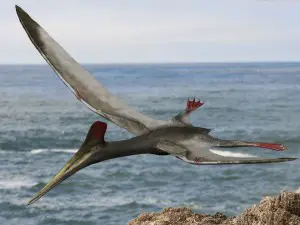
One of the favorite dinosaurs is the pterodactyl, the giant, flying predator of many movies. Scientifically, pterodactyls are not pterodactyls, they are not dinosaur, and they are not giant. Dinosaur is a term that describes reptiles that are descendants of the last common ancestor of the groups Saurishia and Ornithishia. This group includes birds, making them dinosaurs, but excludes pterosaurs, the family pterodactyls belong in. Here are some more facts to learn about pterodactyls, including their real name.
Fact 1: The Greek word used to name Pterodactylus means winged finger. This is because the wing went from the forth finger to the ankle. Skin, muscles, and other tissues stretched that length and became a membrane capable of supporting flight. Other species of pterosaurs had a furry coating on their wings, but pterodactylus did not.
Fact 2: Pterodactylus was the first identified flying reptile and was given the popular but incorrect name of pterodactyl. Popular culture also has pterodactyls as large enough to eat a grown human, often without chewing. Pterodactylus only had an adult wingspan of 5 feet, compared to the 6 to 7.5 feet wingspan of American Bald Eagle, and other species of pterosaurs are thought to be smaller. Â
Fact 3: Carnivorous, pterodactylus ate fish and other small animals. The adult pterodactylus skulls were long and narrow, with large, conical teeth. These 90 teeth were smaller the further away they got from the ends of the jaw. The skull and jaws were straight, not curving to eat a specialized food source. A hooked beak on the tips of the upper and lower jaws was the same size as the nearest teeth.
Fact 4: The long neck was covered in bristle like hairs, called pycnofibres. Pterodactylus had a throat pouch, such as a modern day pelican has. To bird scientists, this is called a gular skin. A soft tissue crest on the skull served as a display that grew with the pterodactylus.
Fact 5: As the pterodactylus grew, changes were made to the size and shape of the skull, teeth fell out or grew, and the proportions of the bones changed. This led to misidentification of juvenile pterodactylus as a different species. Molecular analysis has shown that there is, so far, only one valid pterodactylus species, Pterodactylus antiquus.
Fact 6: Since they ate fish, pterodactylus lived at the edge of a sea, near a swampy wetland. Some of the pterodactylus died and fell into that muddy area. As the area dried out, the mud hardened into a limestone encasement for the bodies. This preserved the bones and some of the fleshy parts of the pterodactylus, which is why scientists know as much as they do about them.
Fact 7: In the Triassic Period, 230 to 200 million years ago, small species of pterosaurs lived. It was during the Jurassic and Cretaceous periods that pterodactylus were the most numerous.
Fact 8: Pterosaurs were the first vertebrates to develop powered flight, providing them with a big advantage over their prey.
Fact 9: Small species of pterosaurs were out-competed by the arrival of the early birds. The larger pterosaurs managed to survive until the cataclysmic end of the dinosaur age.
Fact 10: The Italian naturalist Cosimo Collini described the first pterosaur fossil in 1784. He thought they used the long finger for swimming, not flying.










Leave a Reply